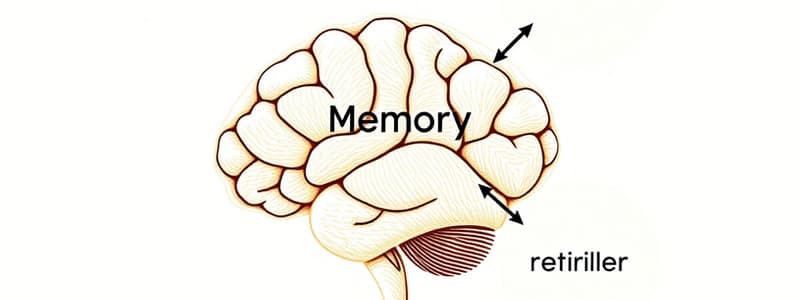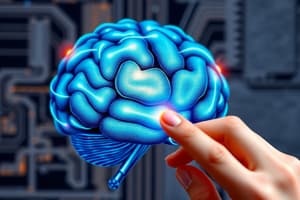Podcast
Questions and Answers
What is the primary function of memory as defined in the content?
What is the primary function of memory as defined in the content?
- To store data permanently for future use
- To enhance cognitive skills and abilities
- To compare past and current experiences for decision-making
- To retain, retrieve, and use information after the original data is no longer present (correct)
How long does short-term memory retain information without rehearsal?
How long does short-term memory retain information without rehearsal?
- About 5 to 10 seconds
- Approximately 30 seconds
- Indefinitely, as long as it is important
- For 10 to 15 seconds (correct)
Which type of memory is primarily responsible for holding information for long periods of time?
Which type of memory is primarily responsible for holding information for long periods of time?
- Sensory memory
- Working memory
- Long-term memory (correct)
- Short-term memory
What is the approximate capacity of short-term memory as discussed?
What is the approximate capacity of short-term memory as discussed?
In the model of memory proposed by Atkinson and Shiffrin, which component serves as the initial stage of incoming information?
In the model of memory proposed by Atkinson and Shiffrin, which component serves as the initial stage of incoming information?
What is the primary characteristic of long-term memory?
What is the primary characteristic of long-term memory?
Which of the following best describes a control process?
Which of the following best describes a control process?
In the context of short-term memory, what does rehearsal refer to?
In the context of short-term memory, what does rehearsal refer to?
What phenomenon allows a viewer to not notice the dark intervals in a film?
What phenomenon allows a viewer to not notice the dark intervals in a film?
What did George Sperling aim to determine through his famous experiment?
What did George Sperling aim to determine through his famous experiment?
What was the average number of letters participants reported in the whole report method of Sperling's experiment?
What was the average number of letters participants reported in the whole report method of Sperling's experiment?
What is sensory memory primarily concerned with?
What is sensory memory primarily concerned with?
Which of the following is an example of persistence of vision?
Which of the following is an example of persistence of vision?
What is the primary finding of Sperling's experiment regarding sensory memory?
What is the primary finding of Sperling's experiment regarding sensory memory?
What is the purpose of the tone in the partial report method?
What is the purpose of the tone in the partial report method?
What type of memory retains sounds for a longer duration after the original stimulus?
What type of memory retains sounds for a longer duration after the original stimulus?
What memory process involves participants recalling stimuli after a delay?
What memory process involves participants recalling stimuli after a delay?
According to the studies by Brown and Peterson, what is the approximate duration of short-term memory?
According to the studies by Brown and Peterson, what is the approximate duration of short-term memory?
What happens to visual information immediately after it is presented, according to Sperling's research?
What happens to visual information immediately after it is presented, according to Sperling's research?
In the delayed partial report method, when is the cue tone presented?
In the delayed partial report method, when is the cue tone presented?
Which of the following best describes short-term memory?
Which of the following best describes short-term memory?
What is the primary function of the central executive in Baddeley's working memory model?
What is the primary function of the central executive in Baddeley's working memory model?
Which effect describes the confusion of letters or words that sound similar?
Which effect describes the confusion of letters or words that sound similar?
In the context of memory, what does the word length effect refer to?
In the context of memory, what does the word length effect refer to?
What phenomenon occurs when repeating an irrelevant sound interferes with memory rehearsal?
What phenomenon occurs when repeating an irrelevant sound interferes with memory rehearsal?
What does the visuospatial sketch pad manage?
What does the visuospatial sketch pad manage?
What is mental rotation as described by Shepard and Metzler?
What is mental rotation as described by Shepard and Metzler?
Why does articulatory suppression eliminate the word length effect?
Why does articulatory suppression eliminate the word length effect?
Which process is involved in creating visual images in the absence of physical stimuli?
Which process is involved in creating visual images in the absence of physical stimuli?
What is the main role of the Central Executive in working memory?
What is the main role of the Central Executive in working memory?
Which characteristic is indicative of perseveration?
Which characteristic is indicative of perseveration?
How does the episodic buffer enhance working memory capacity?
How does the episodic buffer enhance working memory capacity?
What is a common outcome of damage to the prefrontal cortex, as exemplified by Phineas Gage?
What is a common outcome of damage to the prefrontal cortex, as exemplified by Phineas Gage?
What aspect of attention is primarily managed by the Central Executive?
What aspect of attention is primarily managed by the Central Executive?
What is an effect of long-term memory on working memory as explained in the context of chunking?
What is an effect of long-term memory on working memory as explained in the context of chunking?
What is NOT a function of the Central Executive?
What is NOT a function of the Central Executive?
Which of the following best describes an individual exhibiting perseveration?
Which of the following best describes an individual exhibiting perseveration?
Flashcards are hidden until you start studying
Study Notes
Memory Overview
- Memory involves the retention, retrieval, and usage of information about stimuli, images, events, ideas, and skills after the original information is gone.
- Sensory memory retains information briefly, allowing for perception continuity of stimuli like facial images.
Types of Memory
- Sensory Memory: Captures information for seconds or fractions of a second, such as the afterimage of a flash.
- Short-Term Memory (STM): Holds information for about 10 to 15 seconds without rehearsal; can contain 5 to 7 items.
- Long-Term Memory (LTM): Stores information for extended periods, from minutes to a lifetime.
Memory Model by Atkinson and Shiffrin
- Proposes three structural features: sensory memory, short-term memory, and long-term memory.
- Introduces control processes, dynamic processes that can differ between tasks, such as rehearsal to retain information in STM.
Encoding and Retrieval
- Encoding: The process of storing information in LTM.
- Retrieval: The process of bringing stored information back to mind.
Sensory Memory Details
- Retains sensory stimulation effects for a very brief period.
- Persistence of Vision: Continued perception of visual stimuli post-exposure; crucial for experiencing films uninterrupted.
Sperling's Experiment on Sensory Memory
- Whole Report Method: Participants average recalled 4.5 out of 12 letters shown briefly.
- Partial Report Method: Enhanced recall when cued instantly by tone, demonstrating sensory memory's capacity.
- Delayed Partial Report Method: Retention decreases when a delay is added.
Iconic and Echoic Memory
- Iconic Memory: Visual memory retains information for a fraction of a second.
- Echoic Memory: Auditory memory persists for a few seconds, allowing immediate recollection of sounds.
Short-Term Memory Characteristics
- Functions as a temporary storage for current thoughts and knowledge.
- Duration of STM confirmed to be 15 to 20 seconds through studies by Brown, Peterson, and Peterson.
Baddeley's Working Memory Model
- Phonological Loop: Stores verbal and auditory information; affected by phonological similarity and word length effects.
- Visuospatial Sketch Pad: Manages visual and spatial information; involved in visual imagery and mental rotation tasks.
- Central Executive: Coordinates the use of the phonological loop and visuospatial sketch pad; regulates attention and task-switching.
Effects on Memory
- Articulatory Suppression: Reduces memory capacity by blocking rehearsal through repeated irrelevant sounds.
- Mental Rotation: Demonstrates the visuospatial sketch pad's ability to manipulate images mentally.
Additional Components of Working Memory
- Episodic Buffer: Provides extra capacity by linking LTM with working memory, enabling chunking and meaningful associations.
Impact of Prefrontal Cortex Damage
- Damage leads to impaired attention control and altered personality traits, as evidenced by Phineas Gage's case.
- Frontal lobes are crucial for planning and social behavior, illustrating their role in memory function.
Conclusion
- Working memory involves dynamic interaction between its components and plays a critical role in handling and processing information in everyday situations.
Studying That Suits You
Use AI to generate personalized quizzes and flashcards to suit your learning preferences.



